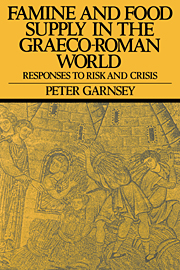Book contents
- Frontmatter
- Contents
- List of tables and figures
- Preface
- Abbreviations
- Maps
- PART I THE INCIDENCE AND SEVERITY OF FOOD CRISIS
- PART II SURVIVAL STRATEGIES
- 4 Subsistence and survival: the peasantry
- 5 Supply and distribution: urban communities
- PART III FOOD SUPPLY AND FOOD CRISIS IN ATHENS C. 600–322 BC
- PART IV FOOD SUPPLY AND FOOD CRISIS IN ROME C. 509 BC – AD 250
- CONCLUSION
- Bibliography
- Index
5 - Supply and distribution: urban communities
Published online by Cambridge University Press: 12 November 2009
- Frontmatter
- Contents
- List of tables and figures
- Preface
- Abbreviations
- Maps
- PART I THE INCIDENCE AND SEVERITY OF FOOD CRISIS
- PART II SURVIVAL STRATEGIES
- 4 Subsistence and survival: the peasantry
- 5 Supply and distribution: urban communities
- PART III FOOD SUPPLY AND FOOD CRISIS IN ATHENS C. 600–322 BC
- PART IV FOOD SUPPLY AND FOOD CRISIS IN ROME C. 509 BC – AD 250
- CONCLUSION
- Bibliography
- Index
Summary
FIVE RESPONSES
States seeking to avoid food crisis or reduce its effects had in principle the following options:
Extend domestic production: by increasing the proportion of home territory under cultivation, or by raising productivity on existing arable.
Extend the territory under control at the expense of other communities: imperialism.
Export a proportion of the population, so as to reduce the aggregate consumption requirements of the community: colonisation.
Import staple food items through trade and other methods of exchange.
Distribute available foodstuffs through the community to ensure the survival of the ordinary citizen consumer.
Of options 1 and 2, the more thorough exploitation of home territory and the exploitation of the territory of another state, the first is more or less an empty category. From time to time and in a variety of historical contexts (Attica and the Argolid in the fourth century BC are possible examples), land under cultivation was extended and higher productivity sought through intensification of farming practices. But this was done as a consequence of factors such as demographic pressure, not government direction. Civic governments did very little to regulate agriculture within their territories.
The second option, imperialism, was successfully exploited by relatively few states. Athens was one such, especially between 478/7 and 413/12, when her power at sea was unrivalled. During this period the Athenians were in a position to monitor and control the longdistance movement of grain, notably from the Black Sea, reduce enemies by blockade, feed a population far more numerous than their home territory could support, export citizens as settlers or garrisons on conquered land – and avoid food crises.
- Type
- Chapter
- Information
- Famine and Food Supply in the Graeco-Roman WorldResponses to Risk and Crisis, pp. 69 - 86Publisher: Cambridge University PressPrint publication year: 1988

